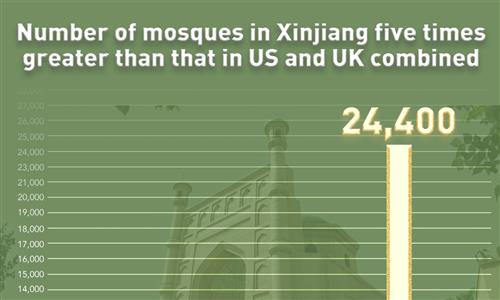
Illustration: Chen Xia/Global Times
Once a remote area, Northwest China's Xinjiang Uygur Autonomous Region has become a vanguard of China's export growth, a further sign that the migration of export-oriented manufacturing from eastern coastal areas to western regions is gaining momentum amid the nation's supply chain restructuring and upgrading.If Xinjiang can transform itself into a new manufacturing center in China, it will have a profound and long-term impact on the domestic economy and even the entire Asian industry chain.
In 2023, Xinjiang's foreign trade totaled 357.33 billion yuan ($50.42 billion), a year-on-year increase of 45.9 percent, ranking second among China's provincial-level regions in terms of growth.
Investment coming from outside the region increased by 16.5 percent. The actual utilization of foreign investment surged by 48.3 percent.
The figures highlighted in the regional government work report during the annual session of the Xinjiang people's congress, which opened on Tuesday, reflect the strong momentum of industrialization in Xinjiang as well as the role of industrialization in expanding trade, attracting investment and enhancing the well-being of the local population.
While Western media outlets claim China no longer has a prominent comparative advantage in labor-intensive industries, the country has found ways to overcome challenges and offset the negative impact of increased labor costs on Chinese factories.
China's labor-intensive manufacturing and electronics production, which were once concentrated in eastern coastal areas, have begun gradually moving to western inland areas such as Xinjiang. These areas have relatively low labor costs and other industrial advantages.
In 2023, labor-intensive products as well as mechanical and electrical goods accounted for about 85.7 percent of Xinjiang's total foreign trade. The rapid growth of those exports adds to evidence that the industry chain is migrating at a pace faster than expected, and therefore greatly increases the possibility of Xinjiang becoming a new manufacturing center in China.
In the coming years, industrial migration will probably accelerate further. The work report of the regional government proposed that Xinjiang will form a modern industrial system that has significant Xinjiang characteristics and advantages.
This year, Xinjiang will focus on building eight industrial clusters for grain, oil, cotton, textiles and clothing, new energy and materials, and other sectors.
Xinjiang is expected to expand preferential policies to attract investment in industries such as textiles. This will accelerate the migration of labor-intensive industries.
The region has over recent years made continuous efforts to improve its business environment, and to foster manufacturing industries and emerging sectors as economic anchors. The lives and property of people of all ethnic groups are fully safeguarded.
Foreign direct investment in Xinjiang continued to improve last year, setting a new record and proving that a certain country's long-arm jurisdiction and crackdown against the region are failing. Foreign companies have voted with their feet by choosing Xinjiang instead of believing the rumors from Western media outlets.
Double-digit investment growth has sent a clear signal that foreign companies approve of Xinjiang's business climate. With unique geographical advantages, Xinjiang is committed to making itself the gateway of China's westward opening-up. It can be expected that investment from other Chinese provinces and regions and overseas will further increase in 2024.
Industrialization and urbanization are ongoing in Xinjiang, and even the most remote areas still have the potential to upgrade their consumption. These are the guarantees of economic growth. Xinjiang's economic development is a dividend for the whole region.
Xinjiang is increasingly becoming an important import market and investment destination. Metal ores and sand, agricultural products, mechanical and electrical goods, unwrought copper and copper materials are Xinjiang's main imported commodities. With the development of its economy, Xinjiang's imports of industrial raw materials and consumer goods will increase, having a profound impact on the regional supply chain.
Despite Western smears and malicious crackdowns, Xinjiang has entered the fast lane of development. It is possible that Xinjiang will become another manufacturing center in China, constituting an important part of the story of China's manufacturing transformation and upgrading.
The author is a reporter with the Global Times. bizopinion@globaltimes.com.cn



